Lamprechtsofen
Useful Information
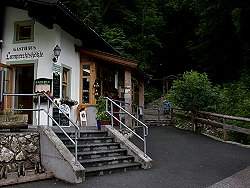
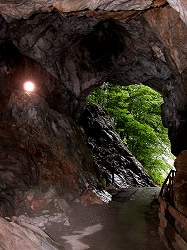

| Location: |
Obsthurn 28, 5092 Obsthurn.
B311 Saalachtal Bundesstraße between Lofer and Saalfelden. About 2 km NW off Weißbach. (47.5259583, 12.7391985) |
| Open: |
MAY to JUN daily 9:30-17. JUL to AUG daily 9:30-18. SEP daily 9:30-17. [2025] |
| Fee: |
Adults EUR 7,50, Children (6-14) EUR 4. Groups: Adults EUR 6,50, Children (6-14) EUR 3,50. [2025] |
| Classification: |
 Karst Cave Karst Cave
 river cave. river cave.
 Underground Power Plant Underground Power Plant
|
| Light: |
 Incandescent Incandescent
|
| Dimension: | VR=-1,727 m, L=60,000 m, A=660 m asl. |
| Guided tours: | D=90 min, L=700 m, St=392. |
| Photography: | allowed |
| Accessibility: | no |
| Bibliography: |
Wolfgang Gadermayr (2021):
Hydrogeologische Messungen im Lamprechtsofen bei Lofer – Kann man die alpine Erderwärmung in den Quelltemperaturen erkennen?,
23. Geoforum Umhausen Tirol, 2021.
pdf

|
| Address: |
Lamprechtshöhle, Emrah Sahin, Obsthurn 28, Weißbach über A-5090 Lofer, Cell: +43-676-44-80-791.
E-mail: |
| As far as we know this information was accurate when it was published (see years in brackets), but may have changed since then. Please check rates and details directly with the companies in question if you need more recent info. |
|
History
| 1650 | first mentioned in a document in connection with dead treasure hunters. |
| 1701 | the cave was closed to provide damage by treasure hunters. |
| 1878 | first scientific exploration by the speleologists Anton von Posselt-Czorich (*1854–✝1911). |
| 22-JAN-1883 | speleological exploration by Ferchel and comrades. |
| 1883 | Start of development as a show cave by the Stainer brothers on behalf of the Österreichischer Touristenklubs. |
| 1905 | several human sekeletons discovered, probably the remains of treasure hunters. |
| 1905 | 600 m of the cave were opened to the public. |
| 1962 | After surveying the cave to a length of 1,400 metres, the exploration of the Lamprechtsofens is considered complete. |
| 1962 | First dive through the Bocksee siphon by the divers Gustav Papacek and A. Koppenwallner. |
| 04-JAN-1991 | four Germans, cavers from Nuremberg, were trapped in the cave for one day. |
| 05-SEP-1998 | after heavy rain the cave was flooded while a cave tour with 14 visitors from all over the world were inside the cave. |
| 19-AUG-1998 | Polish speleologist discover connection to Pl-2 cave, which makes the cave the deepest cave of the world with 1,632 m. |
| 01-JUN-2001 | World cave depth record taken by Voronya Cave (Krubera Cave) in Abkhazia, Georgia (-1710 m). |
Description

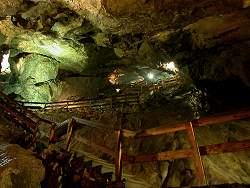

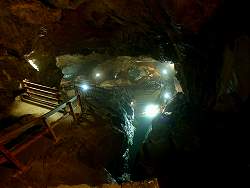
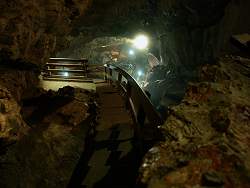

The Lamprechtsofen, also called Lamprechtshöhle or Lamprechtsofenhöhle, is located in the northernmost outcrop of the Leoganger Steinberge. A local legend explains how the cave got its name.
Many centuries ago, Knight Lamprecht, who owned a castle in this valley, is said to have brought back a treasure from a crusade.
His two daughters inherited the treasure, but soon the greedier one stole her sister’s share and hid it in the Lamprecht Cave.
local legend.
In the centuries that followed, many people searched the cave for the treasure. Their futile endeavours took on such alarming proportions that the regional government of the Prince-Bishopric of Salzburg had the cave walled up in 1701. This is of course quite pointless, as the entrance is a spring through which the cave river emerges. Several times a year, during the snowmelt and after heavy rain, a flood rolls through this entrance and destroys any fixtures quite quickly. It is therefore impossible to visit the cave during heavy rain or in spring.
In 1998, show cave visitors were trapped in the cave. A group of 14 cave tourists, including seven children, had to stay in the cave from late afternoon until they were rescued at 11.00 pm. The water had risen very quickly due to heavy rainfall. This situation is annoying, but not at all dangerous. Only a short section is flooded, most of the cave is still dry. After a while it gets a bit chilly, so the cave management has set up a large box with warm blankets and food in the cave. However, this was not an isolated incident, and a number of measures were taken to alleviate the situation, the emergency crates were just the beginning. The cave has flood alarms that cave visitors can activate if they realise they are trapped, allowing the rescue services to determine how many people are in the cave. An alarm system has also been installed that prompts visitors to leave the cave quickly in the event of danger, a request that should definitely be honoured. The weather is now monitored and the cave is briefly closed if the weather conditions are favourable. As a result, the number of inclusions has not only been reduced, but brought to zero.
However, visitors to the show cave are only in the cave for a short time; if a thunderstorm threatens, visits are simply suspended for a while. In January 1991, a group of cave explorers from Nuremberg were trapped in the cave. They had already been in the cave for two days when the weather outside changed and melting snow caused a flood. This is not really a tragedy, the cave explorers could certainly have bivouacked in the cave for another day. After heavy rain it usually only takes a few hours for the water to recede, but when the snow melts it can take longer. That is why they were rescued after several hours by a team of 17 Austrian cave explorers, including two divers.
The Lamprechtsofen is the lowest level of a cave system, while the upper levels are relict, which means they have no flowing water, the lowest level is active, which means it is a river cave. What is unusual is that it is not an underground river with meanders, rapids and the occasional small waterfall. Instead, the main channel is huge, rises steeply, and the water flows at a steep gradient in a whole series of waterfalls towards the exit. The reason for this is the geology: a layer of poorly soluble dolomite is overlaid by Dachstein limestone, in which the cave has developed. Due to the folding of the Alps, however, this layer boundary is very steeply inclined, and therefore the cave follows this inclination. The fracturing of the Dachstein limestone, also a result of tectonics, and the rock stresses, i.e. the weight of the overlying rock, caused the ceiling to collapse on a massive scale. The collapsed material was continuously transported out of the cave by the stream, aided by the steep gradient. And so large rooms such as the Passauer Dom (Passau Cathedral) or Lamprechtsdom (Lamprecht Cathedral) were formed.
Show caves should be easy to navigate and have few dangers, which is why river caves are rarely developed into show caves. The Lamprechtsofen is an exception, not only is it very strenuous due to the ascent, the water is not only unsuitable for boating, it is downright dangerous. There are also no impressive sinter formations or ice. A waterfall, underground rapids, lakes and the enormous size of the cave easily make up for this! In other words, this is an exceptional show cave, even for Austria.
In August 1998 a team of ten cavers from Salzburg and Krakau found a connection between Lamprechtsofen Cave and the PL-2 cave system.
The height difference of this united cave system was 1,632 m and made this cave the world’s deepest cave!
Its new length of over 50 kilometres was also remarkable.
Lamprechtsofen’s fame as the deepest cave in the world lasted only three years.
In June 2001, a deeper cave was explored in Georgia.
The deepest cave in the world is now the
 Voronya pestera
(Krubera Cave) in Abkhazia, Georgia, which was 1.705 metres deep at the time.
The fact that the Krubera quickly reached a depth of 2,140 m, but was surpassed by the neighbouring Veryovkina in 2017, shows how fleeting this title is.
Research continues, and such superlatives are constantly changing, unfortunately cave guides tend to tell a superlative once learnt for decades, even if it is no longer true.
Voronya pestera
(Krubera Cave) in Abkhazia, Georgia, which was 1.705 metres deep at the time.
The fact that the Krubera quickly reached a depth of 2,140 m, but was surpassed by the neighbouring Veryovkina in 2017, shows how fleeting this title is.
Research continues, and such superlatives are constantly changing, unfortunately cave guides tend to tell a superlative once learnt for decades, even if it is no longer true.
Here at the Lamprechtsofen, marketing has taken to calling it the "longest through cave in the world". However, this is such an abstruse nonsense that it’s almost funny again. A "through cave" is a cave that has more than one entrance, so you can walk through it. Every cave system above a certain size has more than one entrance, it’s simply a matter of statistics. So the longest known cave in the world, Mammoth Cave, is also the longest through cave, at over 500 kilometres long. The Lamprechtsofen is the 67th longest cave in the world [2025], so there are probably 66 through caves in the world that are longer than the Lamprechtsofen.
However, the real superlatives don’t really need to hide. The cave is the deepest cave in Austria and the 6th deepest cave in the world [2025]. However, these are only valid until something deeper is discovered...
The Lamprechtsofen is operated by the Deutschen Alpenverein Sektion Passau (Passau section of the German Alpine Club). While the association is responsible for maintenance, the day-to-day operation is the responsibility of the leaseholder. Emrah Sahin runs the restaurant at the entrance to the cave and the show cave. Over the years, the cave has been visited both with and without a guide. The advantage with a guide is of course that you are informed about interesting facts and can ask questions. The advantage without a guide is that you don’t have to wait for the next tour, you can take as much time as you like, and you can take photos at your leisure. As far as we know, the cave is currently open to visitors without a guided tour. One last warning, the cave only accepts cash, which we think is great in this day and age when you’re forced to use credit cards and PayPal. Not everyone shares this opinion, but who can take someone seriously, who doesn’t have €7.50 in their pocket (the entrance fee is at the lower end of the spectrum).
- See also
 Search DuckDuckGo for "Lamprechtsofen"
Search DuckDuckGo for "Lamprechtsofen" Google Earth Placemark
Google Earth Placemark OpenStreetMap
OpenStreetMap Lamprechtsofen - Wikipedia (visited: 25-JUL-2025)
Lamprechtsofen - Wikipedia (visited: 25-JUL-2025) Die Lamprechtshöhle, offizielle Website
Die Lamprechtshöhle, offizielle Website  (visited: 25-JUL-2025)
(visited: 25-JUL-2025) Die Lamprechtshöhle - Faszination Höhle
Die Lamprechtshöhle - Faszination Höhle  (visited: 25-JUL-2025)
(visited: 25-JUL-2025) Der Lamprechtsofen bei Lofer / A by Franz Lindenmayr
Der Lamprechtsofen bei Lofer / A by Franz Lindenmayr  (visited:25-JUL-2025)
(visited:25-JUL-2025) Lamprechtsofen - Photo gallery of the FHKF (visited:25-JUL-2025)
Lamprechtsofen - Photo gallery of the FHKF (visited:25-JUL-2025) Lamprechtshöhle (visited:25-JUL-2025)
Lamprechtshöhle (visited:25-JUL-2025)
 Index
Index Topics
Topics Hierarchical
Hierarchical Countries
Countries Maps
Maps